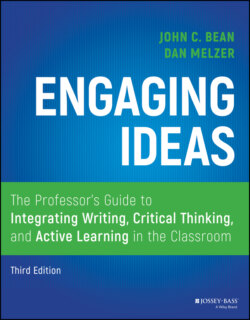Читать книгу Engaging Ideas - John C. Bean - Страница 42
Misconception 1: Emphasizing Writing and Critical Thinking in My Courses Will Take Time Away from Content
ОглавлениеMany faculty, understandably concerned about coverage of material, do not want to shift class time away from content. In addressing this conundrum, one must first distinguish between how much a teacher “covers” in a given course and how much students actually learn in a meaningful and usable way. Much of the literature on best pedagogical practices suggests that less is more. For example, Robert Zemsky (2009), founding director of the University of Pennsylvania's Institute for Research on Higher Education, argues that “no one has sufficient time or gray matter to master a knowledge base that is growing exponentially every decade or so.” Rather than focus exhaustively on content coverage, Zemsky urges educators to prioritize content, focusing on high‐priority material while simultaneously teaching the critical thinking and problem‐solving skills needed to acquire and apply new knowledge:
Discussions of the changing nature of knowledge often morph into what a successful learning outcome would be if detailed content were actually becoming less important than a well‐executed learning process. The former is static; the latter is dynamic in the sense that learning processes change as the learner seeks new knowledge and tackles new problems.
In our experience, integrating writing and critical thinking components into a course can increase the amount of subject matter that students actually learn. This assertion may seem counterintuitive until one realizes that many kinds of short assignments—particularly short, formal assignments or low‐stakes exploratory writing—can restructure the way students study outside of class. Critical thinking tasks—which require students to use their expanding knowledge of subject matter to address disciplinary problems—motivate better study habits by helping students see their learning as purposeful and interesting. If tasks are designed to improve academic reading (see chapter 7), students often learn to read textbooks and other course materials more powerfully and to interact more critically with primary source readings. With more confidence that students can learn from assigned readings, teachers can, if they choose, redirect some class time away from lecturing over the readings toward critical discussions, small‐group problem‐solving, or other critical thinking activities. The emphasis throughout this book is on helping students learn the subject matter of a course at a deeper and more intellectually mature level.
